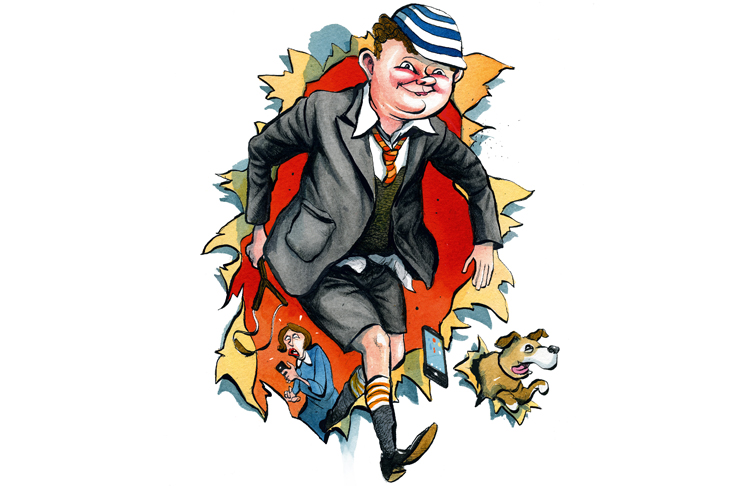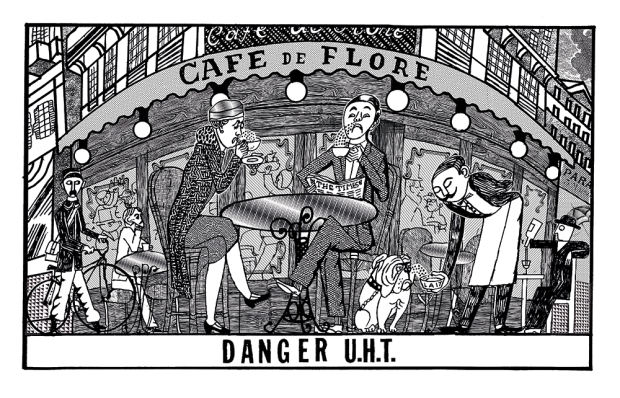Now that the Scots have banned people from smacking kids — both their own and, presumably, those that belong to other people — I suppose we will dutifully follow suit and another one of life’s harmless little pleasures will have bitten the dust. Fair enough, we can still say horrible, frightening things to them in order to exert a bit of discipline. But the immense satisfaction of hearing them howl in pain from a sharp slap to the leg, or a nasty pinch to the upper arm, will be gone for good.
Not many parents do hit their kids any more. It is already a vanishing art. Smacking unruly brats has been de trop for ages, especially among the middle classes. These days we are expected merely to smile indulgently as they shriek their little lungs out in a restaurant or on an aeroplane (where they shouldn’t be in the first place, which of course is why they’re shrieking their little lungs out).
It hasn’t made the kids any happier, though. A recent Unicef report discovered that British brats were the least happy in the western world. Rates of depression and anxiety among children have reportedly increased by 70 per cent in the last 25 years, and the number turning up in A&E wards reporting psychiatric conditions has doubled since 2009. In a 2016 survey for Parent Zone, 91 per cent of teachers reported seeing more mental illness among their charges. A year later it was reported that suicides among teenagers had reached a 14-year high. Whatever way you look at it, we are not bringing up our children terribly well. Something is wrong — perhaps many things are.
The mental illness issue is evident from our universities. The safe-spaces stuff, the terror of encountering an opinion which differs from their own or which might offend their sensibilities, is surely evidence of a profound derangement.
I asked the classics professor Mary Beard where she thought this uber-sensitivity had come from and she replied: ‘Health and safety.’ She has a point, I think, although it is far from the whole of the story. Children are not let loose like they once were: they are corralled permanently inside a suffocating safe space from the moment they are born. The ghost of Jimmy Savile lurks in every shrubbery, ready with a promise of puppies or sherbet bonbons, and so the kids are not allowed outside by themselves until a much older age than used to be the case.
From the age of seven I spent every day of the school holidays as far away from my parents as humanly possible, returning at six for my tea. I would play with friends or just wander by myself. This taught me independence and responsibility, way beyond that of my 12-year-old daughter, whose movements are, I believe, ludicrously restricted. I knew how to get on a bus and a train, how to evade bullies, what time of year and day was best to watch goldfinches and linnets feeding on the teasel seeds in the magical urban wasteland near our house.
There was no organised entertainment, of course — one found one’s own. For me it was football and bird-watching. These days the kids have endless, intensely safe activities — corporate entertainment — programmed for them. As the sociologist Frank Furedi put it: ‘From the moment they get up in the morning to the evening, when they are passed around from one activity to another, literally they have no free time to be children and to relax.’ And all of these activities in exquisitely safe spaces, copiously chaperoned, just in case a mildly grazed knee provokes litigation from some appalled parent. They have no time to themselves and — in our terror, our histrionic swathing and cosseting — no chance to find things out for themselves.
We think we are protecting them, but we are stifling them and harming them. We are preventing them from engaging with the world on their own terms. And coincidentally, we are making them fat. That’s something else we’ve given the kids recently — obesity and diabetes. Why would they not be fat when they are not allowed to venture outside by themselves, not allowed to shin up trees or play football in the street from dawn until dusk?
And then there’s what happens to the kids in school. Here they are egregiously indulged by teachers who seem to want to be their ‘mates’ rather than their instructors. Competition has no place in the modern state school — the kids are not ranked for their abilities, publicly, in each subject, as was the case 30 years ago. If they come 20th out of 20 in maths, they are not told this. They are simply assured that they’ve done their best and shouldn’t worry about it and that judging children by their respective abilities is an unpleasant thing to do. The imperative for the teachers is to try to raise the D students to a C; that’s about it.
Nor are children enjoined to learn, to understand the importance — and the drudgery and boredom — of imbibing facts. There is a joke about the modern approach to teaching. In the old days a child would be given the sum ‘4+3’ and the answer required by the teacher would be ‘7’. Today a child is given the sum ‘4+3’ and the correct answer is to explain how ‘4’ feels about being added to ‘3’. The teachers are terrified of boring the kids with facts. It’s all about how the kids relate to the facts, as if the facts themselves were of scant importance. You can see how that easily morphs into the safe-spaces mindset of university students.
But there is always mental illness to offer them a way out. Mental illness and gender stuff. These are the new, exciting activities of our young people. Enjoined endlessly to express how they feel and to revel in that most valued of all qualities, victimhood, it is scarcely a surprise that many more report mental illness and gender dysphoria. Those states, today, do not have a stigma attached to them. They have instead a very potent cachet.
This isn’t the sum total of why our kids these days are a) unhappy and b) mad; just, in my opinion, the most important contributory factors. You might add to them the rise of divorce — kids from divorced parents or single-parent families are far more likely to end up jobless, involved in criminal activities, addicted to drugs, expelled from school, suffering from mental illness. And the rise of the two-working-parent families where the kids catch only fleeting glimpses of their — what is the word we are meant to use? — guardians. Yet try advancing the theory that divorce and working mums may have resulted in poorer outcomes for the nation’s children and see how far you get. The howl-round will be immediate and cacophonous.
The truth, I think, is that we know most of this intuitively. We want kids, but find them inconvenient to our lifestyles. And the cosseting of the children is a kind of over-compensation, because we know that really we are letting them down.
Got something to add? Join the discussion and comment below.
Get 10 issues for just $10
Subscribe to The Spectator Australia today for the next 10 magazine issues, plus full online access, for just $10.
You might disagree with half of it, but you’ll enjoy reading all of it. Try your first month for free, then just $2 a week for the remainder of your first year.















Comments
Don't miss out
Join the conversation with other Spectator Australia readers. Subscribe to leave a comment.
SUBSCRIBEAlready a subscriber? Log in